Figure 1.
Complexity of neuronal morphology and post-transcriptional regulation. Typical neuron illustrating four gross neuronal anatomical segments: cell body/soma, axonal shaft, dendritic arbor, and growth cone. Inset shows a synapse, with presynaptic and post-synaptic terminals. The post-transcriptional mechanisms highlighted here are AS, RNA transport, and miRNA silencing. AS occurs in the nucleus of the cell body, and is important for generating protein isoforms. Following splicing and mRNA maturation, the transcript can be packaged into transport RNPs, repressed by RBPs and/or miRNAs, delivered to distal sites of the neuron, and locally translated in response to stimulus. Moreover, miRNAs are involved in finely regulating protein levels throughout the cell.

